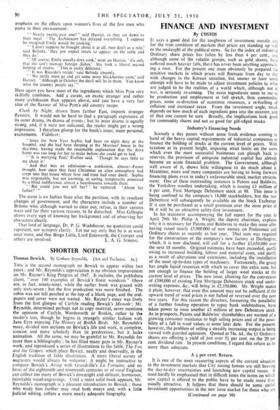SHORTER NOTICE
THIS is the second monograph on Bewick to appear within two years ; and Mr. Reynolds's appreciation is no obvious improvement on Mr. Rayner's King Penguin of 1947. It includes, the publishers claim, " over 100 examples of Bewick's finest woodcuts " (there are, in fact, ninety-nine), while the earlier book was graced with only sixty-seven ; but the first production was more finished. The robin was not left perched at the top of a blank page, and the end- papers and cover were not wasted. Mr. Rayner's essay was lively from the first glimpse of Carlyle reading Bewick's Memoir; Mr. Reynolds, determined perhaps not to copy material, never mentions the opinions of Carlyle, Wordsworth or Ruskin, rather to the reader's loss, though he begins in strangely similar fashion with Jane Eyre enjoying The History of British Birds. Mr. Reynolds's essay, divided into sections on Bewick's life and work, is complete, concise and more scholarly than its predecessor, but it lacks animation. All the same, we may be grateful to Mr. Reynolds for more than a bibliography ; he has filled many gaps in Mr. Rayner's work, and reproduced a series of illustrations to the fable, The Fox and the Grapes, which place Bewick, neatly and deservedly, in the English tradition of fable illustration. A more liberal survey of engravers would always be welcome: it might be instructive to compare Bewick's Aesop with Grandville's La Fontaine, and no lover of the eighteenth and nineteenth centuries or of rural England can collect too many of Bewick's downright and delicate, humorous, inimitable wood-engravings. Until a more solid book appears, Mr. Reynolds's monograph is a pleasant introduction to Bewick ; those who study him further may read both essays and, with a little judicial editing, collate a more nearly adequate biography.


































 Previous page
Previous page